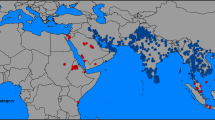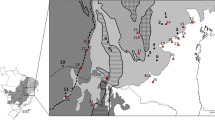Abstract
The endemic large carpenter bee, Xylocopa darwini Cockerell, was the only known pollinator to the Galápagos Archipelago but as early as 1964 locals also spoke of the “dwarf bee of Floreana”. We report the presence of the wool carder bee, Anthidium vigintiduopunctatum Friese, on the island of Floreana and use a species distribution model to predict its distribution in the archipelago. We found that this species has the potential to invade almost one-third the surface area of the Galápagos Archipelago, primarily in low arid areas. Given that wool carder bees are uncommonly collected, we discuss whether this species is a previously undetected native bee or a recent adventive species to the Galápagos.
Similar content being viewed by others
References
Carlquist S (1965) Island life. Natural History Press, Garden City, New York
Causton CE, Peck SB, Sinclair BJ, Roque-Albelo L, Hodgson CJ, Landry B (2006) Alien insects: threats and implications for conservation of Galápagos islands. Ann Entomol Soc Am 99:121–143
Cox PA, Elmqvist T (2000) Pollinator extinction in the Pacific islands. Conserv Biol 14:1237–1239
ESRI (2006) ArcGIS 9.2. ESRI, Redlands, California
Gibbs J, Sheffield CS (2009) Rapid range expansion of the wool-carder bee, Anthidium manicatum (Linnaeus) (Hymenoptera: Megachilidae), in North America. J Kans Entomol Soc 82:21–29
Grigarick AA, Stange LA (1968) The pollen-collecting bees of the Anthidiini of California. Bull Calif Insect Survey 9:1–113
Hijmans RJ, Cameron SE, Parra JL, Jones PG, Jarvis A (2005) Very high resolution interpolated climate surfaces for global land areas. Int J Climatol 25:1965–1978. Available at www.worldclim.org
Hinojosa-Díaz IA, Yáñez-Ordóñez O, Chen G, Peterson AT, Engel MS (2005) The North American invasion of the giant resin bee (Hymenoptera: Megachilidae). J Hymen Res 14:69–77
Linsley EG, Rick CM, Stephens SG (1966) Observations on the floral relationships of the Galápagos carpenter bee. Pan-Pac Entomol 42:1–18
Michener CD (1979) Biogeography of the bees. Ann Mo Bot Gard 66:277–347
Michener CD (2007) The bees of the world, 2nd edn. Johns Hopkins University Press, Baltimore
Miller SR, Gaebel R, Mitchell RJ, Arduser M (2002) Occurrence of the two species of old world bees, Anthidium manicatum and A. oblongatum (Apoidea: Megachilidae), in northern Ohio and southern Michigan. Gt Lakes Entomol 35:65–70
Peck SB (2001) Smaller orders of insects of the Galápagos islands, Ecuador: evolution, ecology and diversity. NRC Research Press, Ottawa, Ontario, Canada
Peck SB, Heraty J, Landry B, Sinclair BJ (1998) Introduced insect fauna of an oceanic Archipelago: the Galápagos islands, Ecuador. Am Entomol 44:218–237
Philipp M, Böcher J, Siegishmund HR, Nielsen LR (2006) Structure of a plant-pollinator network on a pahoehoe lava desert of the Galápagos islands. Ecography 29:531–540
Phillips SJ, Anderson RP, Schapire RE (2006) Maximum entropy modeling of species geographic distribution. Ecol Model 190:231–259
Pimm SL (1991) The balance of nature: ecological issues in the conservation of species and communities. University of Chicago Press, Chicago
Urban D (2002) O gênero Anthidium Fabricius na América do Sul: chave para as espécies, notas descritivas e de distribuição geográfica (Hymenoptera, Megachilidae, Anthidiini). Rev Bras Entomol 46:495–513
Wisz MS, Hijmans RJ, Li J, Peterson AT, Gram CH, Guisan A, NCEAS Predicting Species Distributions Working Group (2008) Effects of simple size on the performance of species distribution models. Divers Distrib 14:763–773
Acknowledgments
We want to thank Joe Wilson, Molly Rightmyer, Claus Rasmussen and an anonymous reviewer for their comments and suggestions that improved this note. This study was supported in part by National Science Foundation grant DEB-0742998.
Author information
Authors and Affiliations
Corresponding author
Rights and permissions
About this article
Cite this article
Gonzalez, V.H., Koch, J.B. & Griswold, T. Anthidium vigintiduopunctatum Friese (Hymenoptera: Megachilidae): the elusive “dwarf bee” of the Galápagos Archipelago?. Biol Invasions 12, 2381–2383 (2010). https://doi.org/10.1007/s10530-009-9651-9
Received:
Accepted:
Published:
Issue Date:
DOI: https://doi.org/10.1007/s10530-009-9651-9




